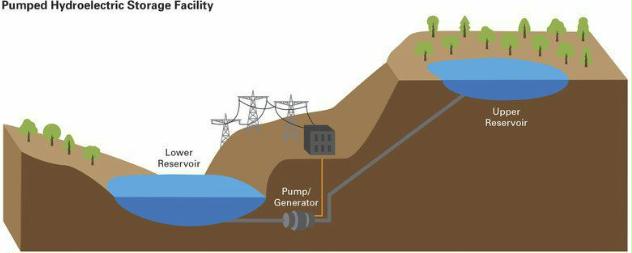
Preface. This is the only commercial way to store energy now (CAES hardly counts with just one plant and salt domes to put more in existing in only 5 states). Though of course hydropower is only in a few states as well, 10 states have 80% of hydropower, and PHS needs to go far above existing reservoirs. There are very few places this could be done.
And the few places that exist are getting huge NIMBY opposition.
Alice Friedemann www.energyskeptic.com Women in ecology author of 2021 Life After Fossil Fuels: A Reality Check on Alternative Energy best price here; 2015 When Trucks Stop Running: Energy and the Future of Transportation”, Barriers to Making Algal Biofuels, & “Crunch! Whole Grain Artisan Chips and Crackers”. Podcasts: Crazy Town, Collapse Chronicles, Derrick Jensen, Practical Prepping, KunstlerCast 253, KunstlerCast278, Peak Prosperity
***
Pumped hydro storage generates power by using electrically powered turbines to move water from a lower level at night uphill to a reservoir above.
During daylight hours when electricity demand is higher, the water is released to flow back downhill to spin electrical turbines. Locations must have both high elevation and space for a reservoir above an existing body of water.
Pumped hydro uses roughly 20–30 % more energy than it produces, with more electricity required to pump the water uphill than is generated when it goes downhill. Nonetheless, pumped hydro enables load shifting, and is important to balance wind and solar power.
Appearances can be deceiving: Pumped hydro is not a Rube Goldberg scheme. Many of you have used a kilowatt or two of pumped hydro yourself. PHS accounts for over 98 % of what little current energy storage exists in the United States, and is the only kind of commercial storage that can provide sustained power over 12 hours (typically, the other 12 hours are spent pumping the water up).
Existing PHS facilities store terawatts of power annually, but account for less than 2 % of annual U.S. power generation. In 2018, the United States had 22.9 gigawatts (GW) of pumped storage hydroelectric generating capacity, compared with 79.9 GW of conventional hydroelectric capacity. This isn’t likely to increase much, since like hydroelectric dams, there are few places to put PHS. Only two have been built since 1995, for a grand total of 43 in the U.S., with most of the technically attractive sites already used (Hassenzahl 1981).
Most were built between 1960 and 1990; nearly half of the pumped storage capacity still in operation was built in the 1970s (EIA 2019).

Existing PHS in the U.S. can store 22 GW, with the potential for another 34 GW more across 22 states, though high cost and environmental issues will prevent many from being built. Additionally, saltwater PHS could be built above the ocean along the West coast, but so far the high cost of doing so, shorter lifespan due to saltwater corrosion, distance from the grid, and concerns of salt seepage into the soil have prevented their development. Underground caverns and floating sea walls are other possibilities, but also aren’t commercial yet.
PHS has a very low energy density. To store the energy contained in just one gallon of gasoline requires over 55,000 gallons to be pumped up the height of Hoover Dam, which is 726 feet high (CCST 2012).
In 2011, pumped hydro storage produced 23 TWh of electricity across the U.S. However, those plants consumed 29 TWh moving water uphill, a net loss of 6 TWh.
So, how many PHS units would it take to give the U.S. that one day of electricity storage, 11.12 TWh? Over 365 days, our 43 existing pumped hydro plants produced two days of energy storage (23 TWh). Thus, the U.S. would need more than 7800 additional plants (365/2 * 43). Rube Goldberg, I can imagine what you would make of this.
FEW PLACES TO PUT MORE
Roger Andrews looked at where PHS seawater reservoirs could be put all over the world and found only three where a combination of favorable shoreline topography and minimal impacts would allow any significant amount of SWPH to be developed – Chile (discussed here), California (discussed here) and, of all places, Croatia (Andrews 2018).
Andrews R (2018) The seawater pumped hydro potential of the world. Energy Matters. http://euanmearns.com/the-seawater-pumped-hydro-potential-of-the-world/
NIMBY
The Navajo are objecting to three PHS in the Black Mesa. They cite the projects’ potential harm to water resources, traditional land uses and wildlife, and the developer’s failure to obtain consent from local communities before seeking federal approval. The projects propose eight new reservoirs across 38,000 acres. Filling them would require 450,000 acre-feet of water, an enormous share of the remaining Colorado River flows. Even under the best-case scenario, up to 8,000 acre-feet would be lost to evaporation each year, which is nearly double the rate of aquifer depletion from historical coal extraction. The applications list the aquifers beneath Black Mesa and the Colorado and San Juan rivers as potential water sources but provide no evidence of availability or legal rights to those sources (CBS 2023).
References
CBS (2023) 18 Navajo Chapters Oppose Huge Pumped Storage Projects Threatening Arizona’s Black Mesa. Center for Biological diversity. https://biologicaldiversity.org/w/news/press-releases/18-navajo-chapters-oppose-huge-pumped-storage-projects-threatening-arizonas-black-mesa-2023-07-14/
CCST. 2012. California’s energy future: electricity from renewable energy and fossil fuels with carbon capture and sequestration. California: California Council on Science and Technology.
Hassenzahl, W.V. ed. 1981. Mechanical, thermal, and chemical storage of energy. London: Hutchinson Ross.

15 Responses to Pumped Hydro Storage (PHS)